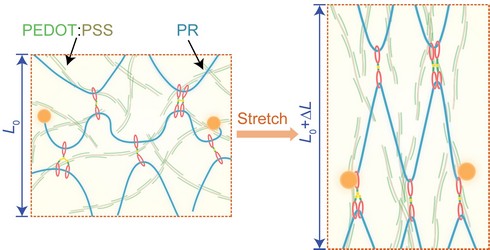
On March 25, Prof. Bao Zhenan’s team from Stanford University and Prof. Hu Wenping’s team from Tianjin University published the study “Topological Supramolecular Network Enabled High-Conductivity, Stretchable Organic Bioelectronics”online in Science, realizing the long-dreamed combination of the great electrical and mechanical performance of the flexible electronic devices.

Through introducing the cross-linked topological network into the widely-used conductive polymer materials, the researchers tremendously improve their mechanical and electrical properties, thereby obtaining the intrinsically stretchable and photopatternable electrode with the record-high conductivity. The resultant film conductivity, after the delicate adjustment of the dopants’ topological and chemical structures, reaches two orders of magnitude better than the previous strategies, and stretchable micro-electrode arrays can be prepared by direct photocuring process.
In recent years, flexible electronic devices have attracted considerable attentions due to their extraordinary compatibility of human bodies. The stability of the devices in operation calls for the coexistence of high conductivity and stretchability of the conductive materials, since great conductivity serves as the foundation for the operation of electronic devices, whereas soft and well-stretchable ones boast better tissue adhesion and higher signal-to-noise ratio during electrophysiological monitoring. Therefore, to maintain good mechanical and electrical properties after micro/nano-patterning paves way for the conformable integration of flexible electronic devices on biointerfaces, but will also become a restriction if it fails to do so.
To tackle this dilemma, conductive polymers (such as PEDOT:PSS) have been extensively used. However, their simultaneous improvement in mechanical and electrical properties remain challenges due to the difficult balance between the demands of charge carrier transport (highly ordered chain arrangement) and flexibility (high degree of conformational freedom), which limits its applications in the preparation of high-precision stretchable devices.
Therein lies the landmark significance of the study: the scholars break through such bottleneck by innovatively integrating PEDOT:PSS with a paired topologically cross-linked network. Researchers select a “mechanically interlocked” geometry with high conformational freedom, endow the material with intrinsic stretchability, high conductivity and photopatternability. The rationally designed structure holds comprehensive mechanical-electrical properties, better than any former patterns.

Such a breakthrough may inspire the development of “impossible” polymeric materials for biomedical engineering, flexible optoelectronics, etc. For instance, such design strategy can decouple the competing mechanical and optoelectronic properties in polymer materials, which may transcend the traditional methods to an unparalleled performance.
For biomedical engineering, the brand-new applications accomplished include the high-resolution electrophysiological monitoring of soft live creatures, and the precise control of single muscle movements through local neuromodulation of the delicate brain stem. These innovations of multimodal biological interfaces can be extended to many other fields like artificial soft robots, flexible brain-computer interfaces, real-time determination of safe entry zones for neurosurgical procedures, etc.
Finally, in the field of flexible optoelectronics, the combination of high conductivity, stretchability, and transparency of the conducting film achieved thereby can be deemed a stretchable “indium tin oxide”. The team expects that the conductors possessing such properties may promote many stretchable circuits and related applications, such as light-emitting diodes, solar cells, photodetectors, and field-effect transistors.
Source from the ScienceNet: https://news.sciencenet.cn/htmlnews/2022/3/476254.shtm
By Han Shiyu
Editors: School of Science, Sun Xiaofang






